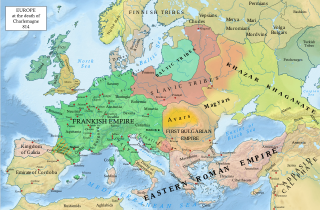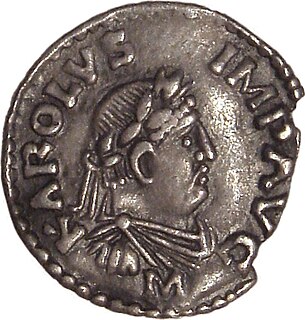
Nürburg is a town in the German district of Ahrweiler, in the state of Rhineland-Palatinate. It is also the name of the local castle, Nürburg Castle, which was built in the High Middle Ages. The name is derived from the Latin word "niger" which means 'black', and burg which means "castle". The castle is made of basalt which usually has black color. The 24 kilometer race track, the Nürburgring, is nearby.

Helfenstein Castle represents the remnants of the fortified castle (burg) Helfenstein of the counts of Helfenstein located above the city of Geislingen an der Steige, Baden-Württemberg, Germany.
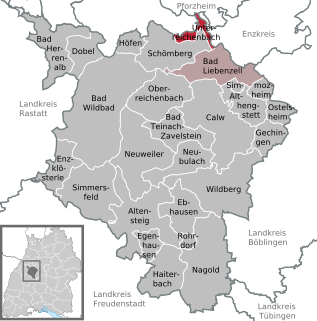
Unterreichenbach is a town in the district of Calw in the Northern Black Forest in Baden-Württemberg in Germany.

Hohenneuffen Castle is a large ruined castle in the northern foothills of the Swabian Alb, above the town of Neuffen in the district of Esslingen in Baden-Württemberg.

Hellenstein Castle is located 70 meters (230 ft) above the city of Heidenheim an der Brenz in eastern Baden-Württemberg, Germany. It was once the home of the Lords of Hellenstein.

Güssenburg Castle is a ruined castle on a hill near Hermaringen in Heidenheim County in Baden-Württemberg, Germany. It was built around 1346, during the High Middle Ages and much of the curtain wall and keep remain.

Kaltenburg Castle is a ruined castle, located in the Lonetal between the cities of Giengen and Niederstotzingen in the district of Heidenheim, Baden-Württemberg, Germany. The castle was built during the High Middle Ages and though ruined, most of the walls are intact.

Achalm Castle is a ruined castle located above the towns of Reutlingen and Pfullingen in Baden-Württemberg, Germany. Situated on the top of a hill at the edge of the Swabian Alb the ruins of the 11th-century castle are topped by a look-out tower from 1838.

Prägrad Castle is a ruined medieval castle in Carinthia, Austria. It is located near Feldkirchen on a hillside above the road to Lake Ossiach.

Münzenberg Castle is a ruined hill castle in the town of the same name in the Wetteraukreis, Hesse, Germany. It dates from the 12th century. It is one of the best preserved castles from the High Middle Ages in Germany.
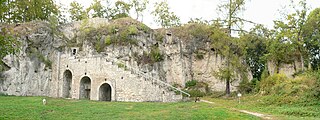
Scharzfels Castle is the medieval ruin of a fortification located east of the village of Scharzfeld in the borough of Herzberg am Harz in central Germany. It lies in a wood on a ridge about 150 m above the Oder valley. For centuries after its construction in the 10th or 11th century it remained an impregnable fortress. The inner ward is built on a dolomite rock outcrop about 20 m high. The castle was first captured after a siege in 1761 during the Seven Years' War and then blown up.

Hertenstein Castle is a ruined spur castle approximately 900 metres (2,950 ft) southwest of the village of Billingsbach, part of the municipality of Blaufelden, in the district of Schwäbisch Hall in the state of Baden-Württemberg, Germany.
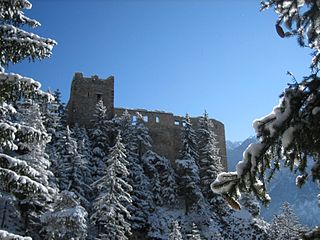
Belfort Castle is a ruined castle in the municipality of Brienz/Brinzauls of the Canton of Graubünden in Switzerland. It is a Swiss heritage site of national significance.

Gräfenstein Castle is a ruined rock castle about 2 kilometres (1.2 mi) east of the village of Merzalben in the German state of Rhineland-Palatinate. It is in the county of Südwestpfalz within the Palatine Forest and is often called Merzalber Schloss. It is built on a rock plateau 12 metres (39 ft) high at an elevation of 447 metres (1,467 ft) above sea level.

Grenzau Castle is a ruined spur castle at 250 m above sea level (NN) near Höhr-Grenzhausen in the county of Westerwaldkreis in the state of Rhineland-Palatinate. It is the only castle in Germany with a triangular bergfried.

Husen Castle is a ruined hill castle of the high medieval period in the valley of the Kinzig in the Black Forest. It is sited above the town of Hausach in the county of Ortenaukreis in the German state of Baden-Württemberg.

The ruins of Zavelstein Castle, a former hill castle, stand at 560 m above sea level (NN) on a hill spur above the Teinach valley on the southeastern edge of the municipality of Bad Teinach-Zavelstein in the county of Calw in the south German state of Baden-Württemberg.
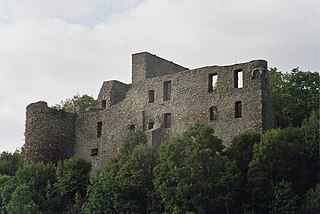
Virneburg Castle is a ruined hill castle on a slate hill, 430 m above sea level (NHN), around which the Nitzbach stream flows. It stands above the village of Virneburg in the county of Mayen-Koblenz in the German state of Rhineland-Palatinate.

On a hill spur above the Eifel village of Monreal in Germany's Elzbach valley, at a height of 350 m above sea level (NHN), stand two neighbouring ruined hill castles: the Löwenburg, also called Monreal Castle, and the Philippsburg. The latter is also known locally as das Rech.





